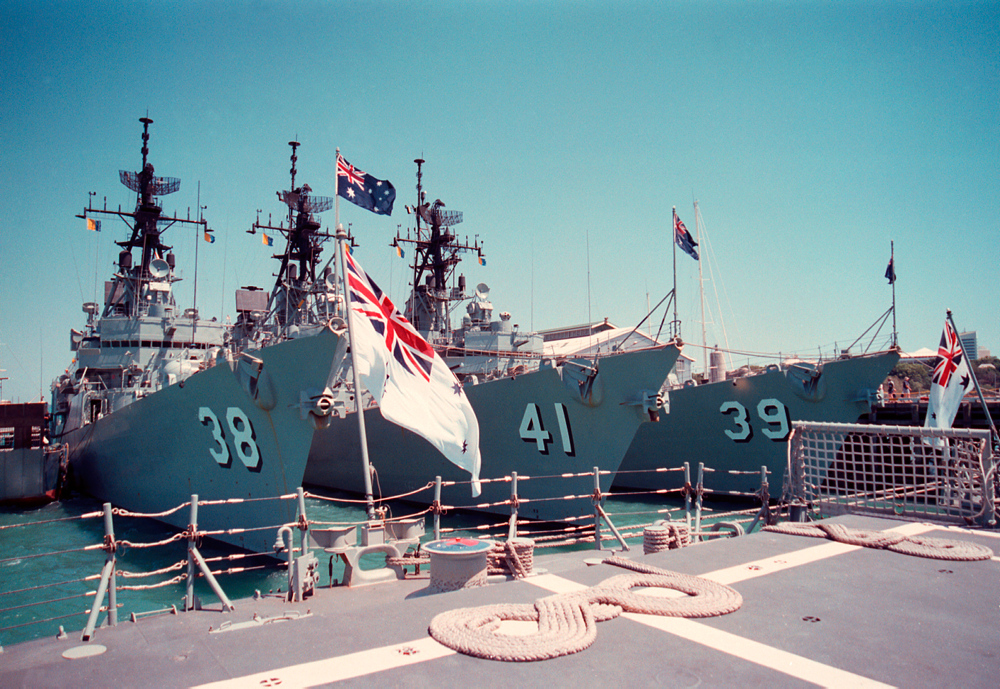
From its origins in 1901 until the late 1950s, through its deep association with the Royal Navy, the Royal Australian Navy became unmistakably British in outlook, practices and culture. It was a relationship of great value to Australia. That comfortable symbiosis had reached its zenith by 1957, when Prime Minister Robert Menzies announced to parliament that Australia would be moving towards standardising Australia’s military services with those of the United States.
The outcome of that decision was that the RAN would successfully transition to be a highly valued ally of the US Navy, already the RN’s replacement as the world’s most powerful maritime force. On that journey, the RAN progressively underwent a major transformation in virtually every dimension, the catalyst for which was its operation of the Charles F. Adams–class guided-missile destroyers.
By 1957, Australia’s government had a clear-eyed view that the nation’s security was much more closely linked with America than with Britain. The Cold War had started, and the threat of communist expansion in Asia was taken seriously. Indonesia was, for a while, regarded as a threat because of its alignment with the Soviet Union.
With the impending demise of its carrier-based aircraft in the early 1960s, the RAN needed an air-defence alternative to fighter planes and decided to acquire ships fitted with surface-to-air guided missiles. The navy’s leaders wanted an extensively modified RN County class. The British beam-riding Sea Slug would be replaced with the US Navy’s semi-active homing Tartar, and the Australian-designed Ikara anti-submarine missile system would be installed. One can only guess what the technical risk, cost and schedule implications would have been.
Fortunately for Australia, that solution didn’t fit with the government’s primary objective of having elements of its navy standardised with America’s navy for the lowest possible price to demonstrate its commitment to ANZUS and SEATO. The RAN had a Hobson’s choice: take the Adams-class guided- missile destroyers or get nothing. The US sold Australia two, and then a third (after Australia asked for it), which were named HMA Ships Perth, Hobart and Brisbane. It was the first time the US had sold its most modern warships to another country.
Soon after arriving in Australia, the Hobart joined the US 7th Fleet on combat operations in Vietnam; the Perth and Brisbane were also rotated in. The destroyers were manned by well-trained crews, with captains who were usually on at least their second command. They wore the RAN’s new white ensign and were unmistakably Australian—a distinction that mattered to both navies. That distinction and mutual respect, earned by a combination of high standards and skills, still underpins one of the great enduring naval associations of the modern era.
New methods of operational logistic support, weapons systems management, air defence, command and control and replenishment at sea were just some aspects of naval warfare brought back to the broader RAN from the destroyers’ experience in Vietnam. The RAN also adopted a much more intensive, multifaceted and independently assessed work-up regime in preparing its ships for deployment based on US Navy practices.
As the destroyers entered service in the mid-1960s, the US Navy was already introducing its digital combat system and had started work on what eventually became Aegis. The RAN was offered software at no charge for a scaled-down tactical data system, which became the RAN’s naval combat system. It was primarily an air-defence system and integrated with the digital Standard Missile system. Management of anti-submarine operations was analogue and clumsy, and electronic warfare integration was poor. All three ships later underwent further modernisation but retained the relatively short range and obsolescent SM1 missile system, making them vulnerable to emerging capabilities in Australia’s region.
Australia’s experience with the Adams destroyers led to the purchase of three, and later a fourth, Perry-class guided-missile frigates from the US. Two more were eventually built in Australia, the last of which has only recently been decommissioned. The RAN therefore operated nine ships of US origin with fundamentally the same combat system and weapons and benefited greatly from that standardisation.
Between 1976 to 2001, officers who had been a head of department in a destroyer had markedly better prospects for promotion to star rank. With two exceptions, in the 53 years from 1955 to 2008, the most senior leadership of the RAN was exercised by 17 officers who came from two distinct backgrounds.
First, for about 27 years, former commanding officers of aircraft carriers were ultimately chosen to become the chief of naval staff. Second, from 1982, for 26 years, the chiefs were former commanding officers of destroyers. Having such an influential group of senior officers ensured that there was a deepening and integration of knowledge acquired from the US Navy, enabling the RAN to unmistakably Australianise its methods and culture, born of its immeasurably valuable RN heritage.
The plan for extensive modernisation of Anzac frigates as replacements for the destroyers was cancelled because of technical risk and cost. This was matched by a drawn-out and expensive modernisation program for four of the RAN’s six Perry-class frigates. Those ships were equipped with the SM2 missile and anti-ship missile defence capabilities but lacked the command and control facilities necessary for modern task group operations. A planning failure meant that the destroyers were in service for at least a decade too long. When HMAS Brisbane was retired from the RAN in 2001, it took until 2017 for HMAS Hobart, the first of the Aegis-equipped Hobart class, to restore the RAN’s capability for advanced air defence and command and control.
For nearly 36 years, the destroyers gave naval options to Australia’s political decision-makers during cold war, limited war and peace. The Adams class empowered the RAN in developing a much greater understanding of what it means, and what had to be done, to become a distinctly Australian and self-reliant medium-power navy.

